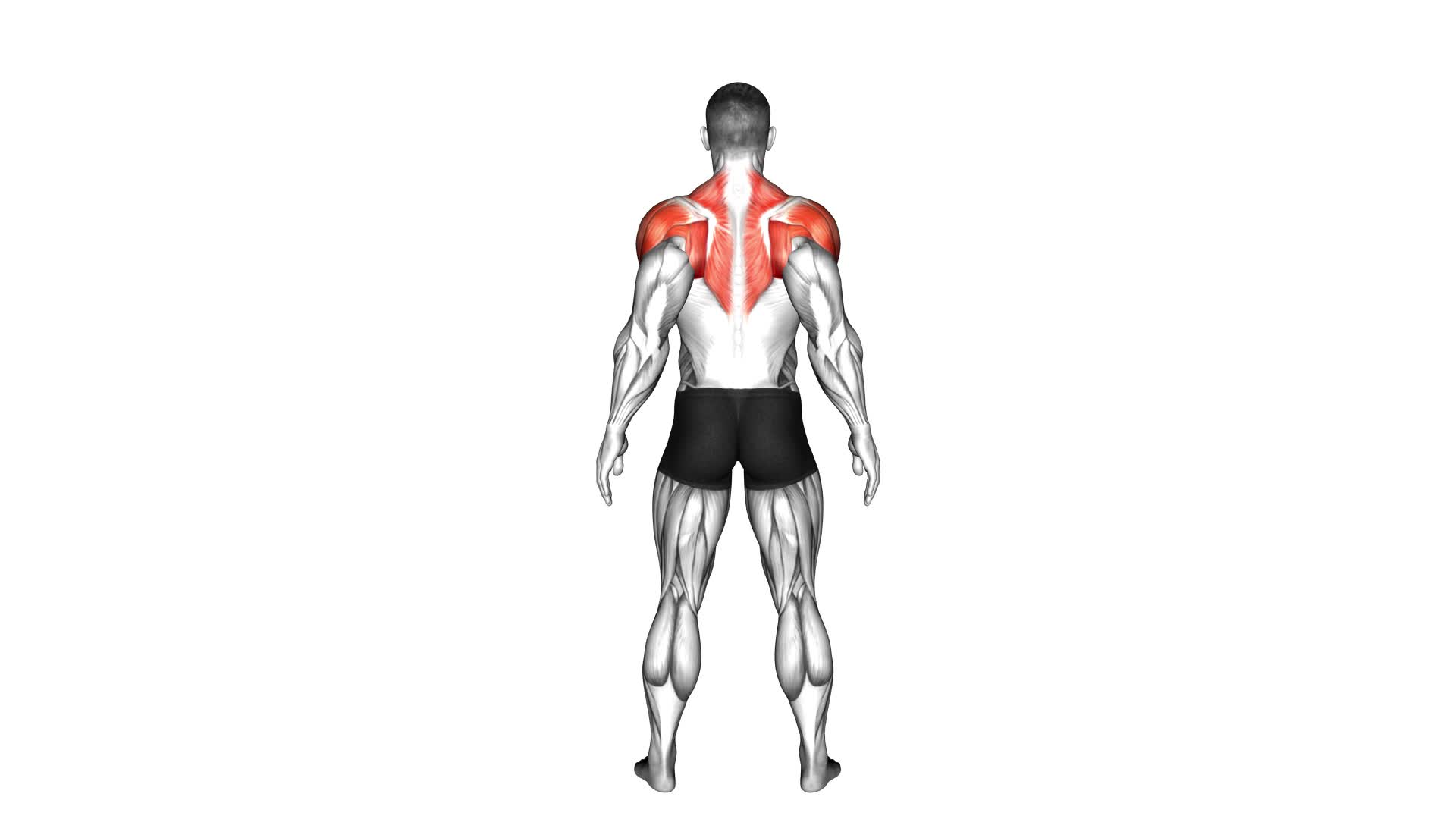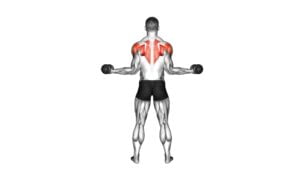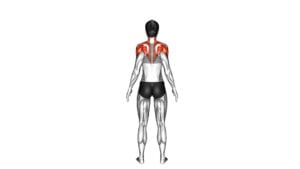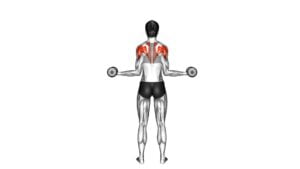Standing Scapular Rotation (male) – Video Exercise Guide & Tips

In this video exercise guide, you'll learn how to properly perform standing scapular rotation to improve your upper body strength and posture.
Watch This Exercise Video
Don't worry, we've got you covered with tips and techniques to ensure you get the most out of this exercise.
Avoid common mistakes and maximize effectiveness with our expert advice.
Whether you're a beginner or an advanced user, we've got variations and progressions to challenge you.
Get ready to take your fitness game to the next level.
Key Takeaways
- Standing scapular rotation improves shoulder joint health and reduces the risk of shoulder injuries.
- It increases upper body strength, stability, and overall function.
- Proper technique involves maintaining good scapular mobility, using a resistance band or light dumbbell, and focusing on squeezing shoulder blades together.
- To maximize effectiveness, perform the exercise slowly and with control, engage core muscles for stability, and maintain good posture throughout.
Benefits of Standing Scapular Rotation
You will experience three key benefits from incorporating standing scapular rotation into your workout routine. Scapular mobility plays a crucial role in maintaining proper posture and preventing shoulder injuries. By performing standing scapular rotation exercises, you can improve the mobility and stability of your shoulder blades, leading to better overall upper body function.
The first benefit of standing scapular rotation is improved shoulder joint health. This exercise helps to strengthen the muscles surrounding the shoulder blades, reducing the risk of impingements and rotator cuff injuries. By promoting proper scapular movement, you can also alleviate tension and stress on the shoulder joint, allowing for smoother and more efficient movement.
The second benefit is increased upper body strength and stability. Standing scapular rotation engages the muscles of the upper back, shoulders, and core, creating a strong foundation for other upper body exercises. By incorporating this exercise into your daily routine, you can enhance your overall strength and stability, leading to improved performance in activities such as weightlifting, sports, and daily tasks.
The third benefit is improved posture and alignment. Standing scapular rotation exercises help to correct rounded shoulders and forward head posture, which are common issues caused by prolonged sitting and poor posture habits. By strengthening the muscles responsible for scapular movement, you can achieve better alignment of the spine and shoulders, resulting in improved posture and reduced risk of postural imbalances.
To incorporate standing scapular rotation into your daily routine, start by standing with your feet shoulder-width apart and holding a resistance band or a light dumbbell in front of you. Keep your arms straight and slightly bend your knees. Begin by retracting your shoulder blades, squeezing them together as if you're trying to hold a pencil between them. Then, protract your shoulder blades, pushing them away from each other. Repeat this movement for 10-12 reps, focusing on maintaining proper form and controlled movement.
Proper Technique for Standing Scapular Rotation
To perform standing scapular rotation with proper technique, start by standing with your feet shoulder-width apart and holding a resistance band or light dumbbell in front of you. It's important to have good scapular mobility, as it allows for optimal movement and stability in the shoulder joint.
Scapular rotation exercises help improve this mobility by targeting the muscles that control the movement of the shoulder blades. To begin the exercise, keep your arms extended in front of you, maintaining a slight bend in your elbows. Keep your shoulders relaxed and down, away from your ears.
Slowly rotate your shoulder blades by squeezing them together and then spreading them apart. As you squeeze your shoulder blades together, imagine you're trying to hold a pencil between them. This will engage the muscles responsible for scapular retraction. Then, slowly spread your shoulder blades apart, as if you're trying to touch your elbows together in front of you. This will engage the muscles responsible for scapular protraction.
Incorporating scapular rotation exercises into a full body workout can help improve overall posture and shoulder stability. It can also enhance performance in exercises that require upper body strength and mobility, such as push-ups, pull-ups, and overhead presses.
Common Mistakes to Avoid
Avoid making the mistake of slouching or rounding your shoulders during standing scapular rotation. Maintaining proper technique is crucial in order to maximize the benefits of this exercise and prevent injury. One common mistake to avoid is allowing your shoulders to hunch forward or roll inward, which can compromise the effectiveness of the exercise and put unnecessary strain on your neck and upper back.
Another common mistake is overcompensating by using excessive force or movement. Remember that standing scapular rotation should be a controlled and deliberate motion, focusing on the muscles of the upper back and shoulders. Avoid using momentum or jerking motions, as this can lead to improper form and potential injury.
It is also important to avoid shrugging your shoulders during the exercise. Keep your shoulders relaxed and down, allowing the movement to come from your scapulae. Engage your core muscles to provide stability and support throughout the exercise.
Lastly, be mindful of your posture and alignment. Stand tall with your chest lifted and your spine neutral. Avoid leaning forward or backward, as this can throw off the proper alignment and reduce the effectiveness of the exercise.
Tips for Maximizing the Effectiveness of Standing Scapular Rotation
To maximize the effectiveness of standing scapular rotation, focus on maintaining proper form and engaging the muscles of your upper back and shoulders. This exercise can be highly effective when performed correctly, but there are a few common misconceptions to be aware of.
One misconception is that you need heavy equipment to do this exercise. In reality, all you need is a resistance band or a pair of light dumbbells. These will provide enough resistance to engage the muscles in your upper back and shoulders without putting excessive strain on your joints.
Another misconception is that you should rush through the exercise. It's important to perform the movement slowly and with control, focusing on squeezing your shoulder blades together and feeling the muscles working. This will maximize the effectiveness of the exercise and help prevent any potential injuries.
Remember to keep your core engaged and maintain good posture throughout the exercise. By following these tips and avoiding common misconceptions, you can maximize the benefits of standing scapular rotation and improve the strength and stability of your upper back and shoulders.
Variations and Progressions for Advanced Users
If you're an advanced user looking to challenge yourself with standing scapular rotation, there are several variations and progressions you can incorporate into your routine. These advanced modifications will help you further strengthen and stabilize your scapular muscles, enhancing your overall upper body strength and mobility.
One challenging exercise you can try is the standing scapular rotation with resistance bands. Attach a resistance band to a stationary object, such as a pole or door handle, and hold the other end with your hand. As you perform the scapular rotation, the resistance from the band will add an extra challenge to your muscles.
Another advanced modification is performing the standing scapular rotation on an unstable surface, such as a Bosu ball or balance board. This will require greater core stability and control as you perform the exercise, further engaging your scapular muscles.
Additionally, you can incorporate weighted objects, such as dumbbells or kettlebells, to increase the difficulty of the exercise. Hold the weights in your hands while performing the rotation, focusing on maintaining proper form and control throughout the movement.
Remember to always start with lighter weights and progress gradually to avoid injury. By incorporating these advanced modifications and challenging exercises into your routine, you can continue to improve your scapular strength and mobility.
Frequently Asked Questions
How Many Repetitions Should I Do for Standing Scapular Rotation?
For standing scapular rotation, the number of repetitions you should do depends on your fitness level and goals. The repetitions count can vary, but it's generally recommended to start with 8 to 12 repetitions per set.
This exercise targets the muscles in your shoulder blades, helping to improve posture and shoulder stability. Regularly performing scapular rotation can also enhance upper body mobility and reduce the risk of shoulder injuries.
Can Standing Scapular Rotation Help Improve Posture?
Standing scapular rotation can indeed help improve your posture. By performing this exercise regularly, you can strengthen the muscles in your upper back and shoulders, which play a crucial role in maintaining good posture.
To reap the benefits, it's important to maintain proper form. Stand tall with your feet shoulder-width apart, keeping your core engaged. Hold a resistance band or light weights in your hands, and rotate your shoulders back and down, squeezing your shoulder blades together.
Is It Necessary to Use Weights for Standing Scapular Rotation?
Using weights for standing scapular rotation isn't necessary, but it can provide additional resistance and intensity to the exercise.
Standing scapular rotation without weights still offers numerous benefits, such as improving shoulder mobility, strengthening the upper back muscles, and promoting better posture.
Variations of standing scapular rotation include using resistance bands, cables, or even bodyweight exercises.
Incorporating these variations can add variety to your workout routine and target different muscle groups.
Can Standing Scapular Rotation Help Prevent Shoulder Injuries?
Standing scapular rotation can be an effective exercise for preventing shoulder injuries. By engaging the muscles in your scapula and improving their strength and mobility, you can enhance the stability and functionality of your shoulder joint. This exercise targets the muscles responsible for proper scapular movement, reducing the risk of imbalances and overuse injuries.
Incorporating standing scapular rotation into your routine can provide numerous benefits, such as improved posture, shoulder stability, and overall upper body strength.
How Often Should I Include Standing Scapular Rotation in My Workout Routine?
To maximize the benefits of standing scapular rotation in your workout routine, it's important to perform this exercise with proper form. By incorporating standing scapular rotation into your routine, you can strengthen the muscles responsible for shoulder stability and improve posture.
Aim to include this exercise at least two to three times per week to see optimal results. Remember to focus on maintaining a neutral spine and engaging your shoulder blades throughout the movement for maximum effectiveness.
Conclusion
In conclusion, standing scapular rotation is a beneficial exercise for improving shoulder mobility and strength.
By following the proper technique and avoiding common mistakes, individuals can maximize the effectiveness of this exercise.
Advanced users can also progress by incorporating variations and progressions.
Overall, incorporating standing scapular rotation into a workout routine can help individuals enhance their upper body function and prevent shoulder injuries.

Author
Years ago, the spark of my life’s passion ignited in my mind the moment I stepped into the local gym for the first time. The inaugural bead of perspiration, the initial endeavor, the very first surge of endorphins, and a sense of pride that washed over me post-workout marked the beginning of my deep-seated interest in strength sports, fitness, and sports nutrition. This very curiosity blossomed rapidly into a profound fascination, propelling me to earn a Master’s degree in Physical Education from the Academy of Physical Education in Krakow, followed by a Sports Manager diploma from the Jagiellonian University. My journey of growth led me to gain more specialized qualifications, such as being a certified personal trainer with a focus on sports dietetics, a lifeguard, and an instructor for wellness and corrective gymnastics. Theoretical knowledge paired seamlessly with practical experience, reinforcing my belief that the transformation of individuals under my guidance was also a reflection of my personal growth. This belief holds true even today. Each day, I strive to push the boundaries and explore new realms. These realms gently elevate me to greater heights. The unique combination of passion for my field and the continuous quest for growth fuels my drive to break new ground.







